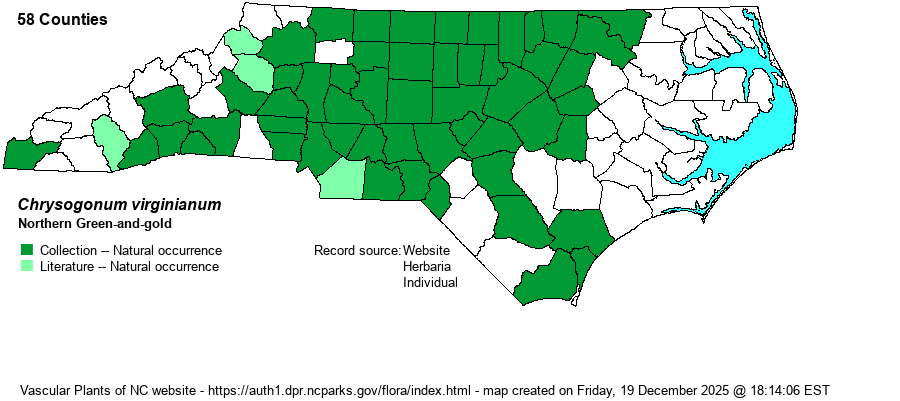| Author | L. | |
| Distribution | Piedmont and Piedmont-like sites on the Coastal Plain; absent from the Sandhills proper. Also ranges into the southern Mountains and barely into low elevations of the northern Mountains. Our map is taken directly from the paper by Nesom in Sida 19: 811-820 and in Phytoneuron 2020-94, with a few additional SERNEC and iNaturalist records added. Note that Nesom (2020) now recognizes 2 species in NC, rather than 2 varieties of virginianum.
Southern PA to southern OH, south to central SC, southern GA, and eastern AL. | |
| Abundance | Common to very common in the Piedmont and extreme upper Coastal Plain; rare to uncommon in the southern Mountains and the southeastern Coastal Plain. Seemingly absent from most of the Mountains and most of the eastern and central Coastal Plain, as well as the Sandhills region. | |
| Habitat | Mesic to dry, deciduous and pine-deciduous forests and woodlands, rocky slopes. Coastal Plain populations occur along brownwater rivers such as the Cape Fear. |
| Phenology | Flowering and fruiting late March - early June, rarely later in summer. Green-and-gold (both species) is one of our handsomest flowers and has one of the longest flowering periods among our spring flora. | |
| Identification | The stems are short, 1.5 feet or less, with ovate leaf blades on long stalks, the leaves crowded near the ground and a rich green color. The heads have 5 bright golden-yellow rays 10-15 mm long and yellow disk florets. C. virginianum is told from C. repens by the absence of stolons and plants occurring singly (vs. plants occurring in patches). | |
| Taxonomic Comments | Readers are referred to the 2001 paper by Nesom in Sida 19, and especially to his update in Phytoneuron 2020-94 for recognition of C. repens. RAB (1968) has most of this taxon named as C. virginianum var. virginianum, but apparently some records listed under the other variety -- australe -- belonged in virginianum (strict sense).
| |
| Other Common Name(s) | Green-and-gold, Golden-star, Golden-knee | |
| State Rank | S5 | |
| Global Rank | G5 | |
| State Status | | |
| US Status | | |
| USACE-agcp | | |
| USACE-emp | | |

